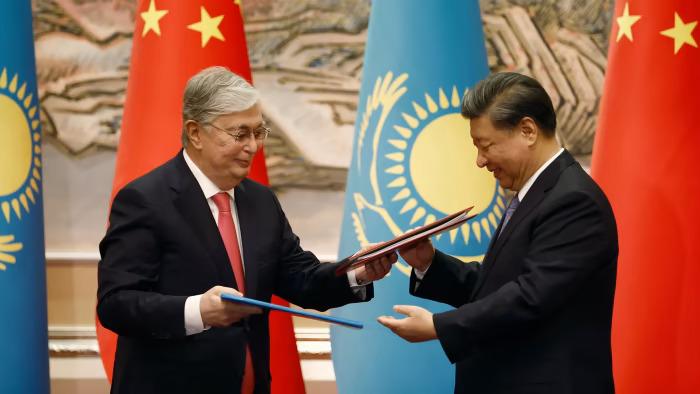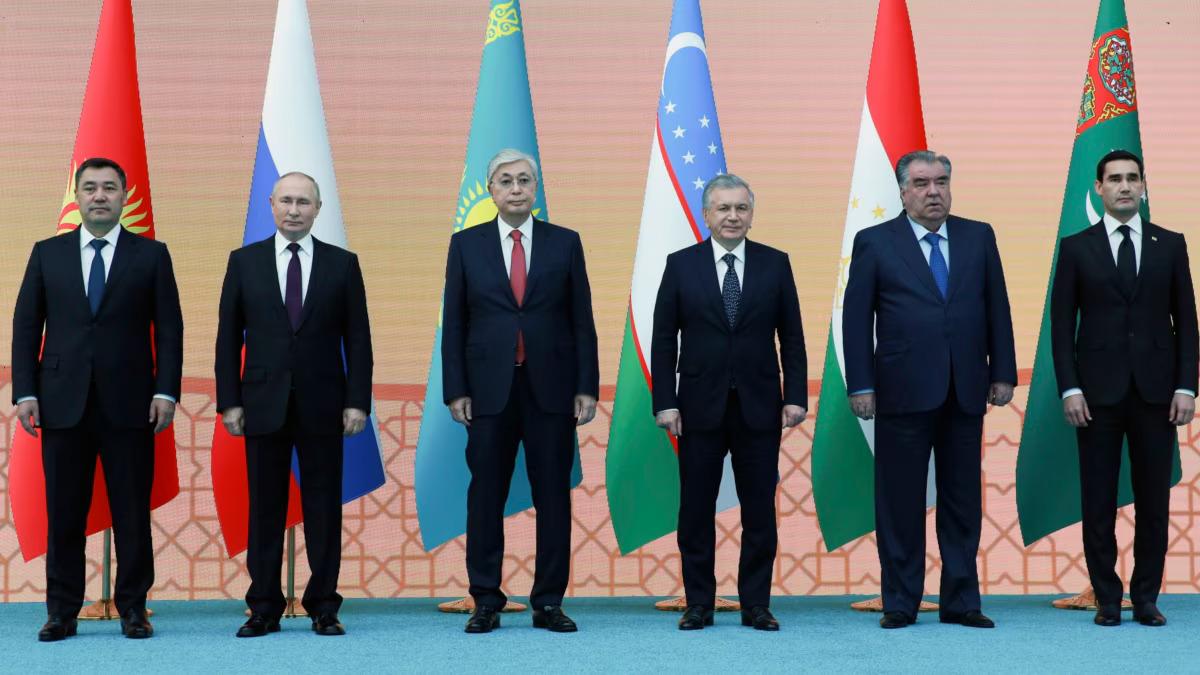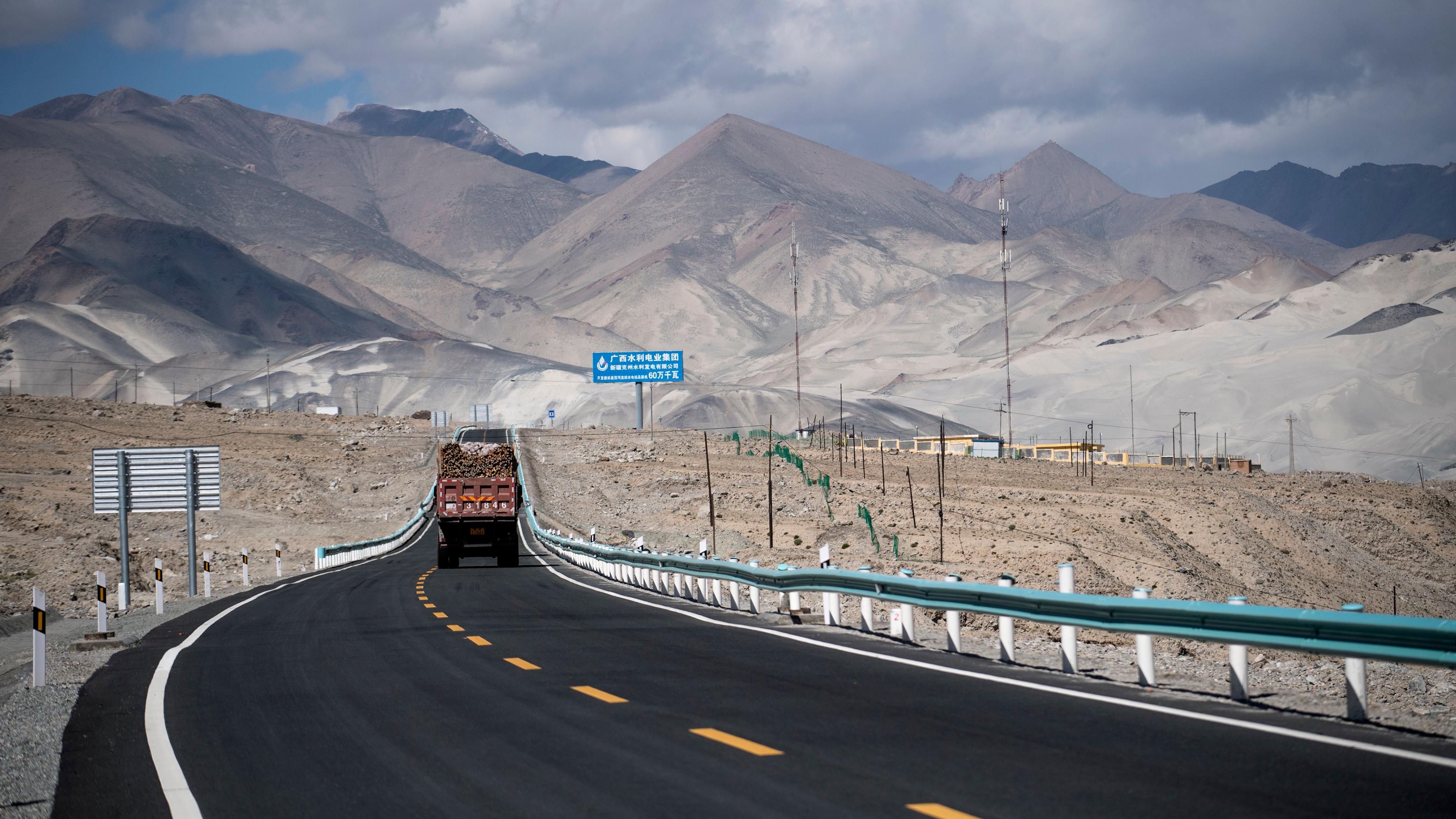Kazakhstan forges new alliances amid shifting geopolitical landscape Gradual shift from Kremlin impact
Central Asian nations, particularly Kazakhstan, Uzbekistan, and Kyrgyzstan, are undergoing significant transformations in their foreign relations strategies. Historically under Russian influence, these nations have recently accelerated their international engagements, extending their diplomatic reach to countries like Türkiye, Azerbaijan, China, and beyond. This shift is characterized by four distinct vectors in their foreign policies: cooperation with the Organization of Turkic States (OTS), retention of membership in Kremlin-dominated economic and military organizations, and strengthening ties with China and the West.
Shift from Russian influence
The Central Asian nations of Kazakhstan, Uzbekistan, and Kyrgyzstan have significantly increased their foreign relations, extending their reach to both neighboring and distant countries. Historically influenced by Russia, these nations have recently accelerated their international engagements, making mutual visits to countries such as Türkiye, Azerbaijan, China, and other nations they seldom interacted with during their early years of independence.
Four distinct vectors are evident in the foreign policies of many Central Asian nations. Firstly, they are eagerly cooperating with the Organization of Turkic States (OTS). Secondly, they maintain their membership in the Kremlin-dominated economic and military organizations. Thirdly, they are strengthening their relations with China, a major buyer of the region’s rich mineral resources and a significant investor in infrastructure and logistics through initiatives like the Belt and Road. Fourthly, they are also prioritizing their economic relations with the West.

These evolving dynamics are further complicated by the ongoing Russian war in Ukraine. Several critical issues need analysis, particularly how Central Asian nations might respond to potential escalations between Moscow and Kyiv. The current geopolitical situation has also prompted Central Asian countries to seek alternative routes for trade and transit, one notable example being the Middle Corridor. This corridor facilitates the movement of goods from China through Central Asia to Europe via Azerbaijan, Georgia, and Türkiye.
Kazakhstan, strategically located between Russia and China, has long pursued a policy of “multi-vector” diplomacy to broaden its international opportunities. The full-scale invasion of Ukraine by Russia in February 2022 has spurred Kazakhstan to expand its relations beyond Eurasia, focusing particularly on the United States and the European Union. This strategic shift aims to mitigate the collateral damage from Western sanctions imposed on Russia.
The ongoing Russian war in Ukraine has dramatically altered the geopolitical landscape, compelling Central Asian nations to reassess their foreign policies. Kazakhstan, for instance, has traditionally pursued a “multi-vector” diplomacy strategy, balancing relations with Russia, China, and Western nations.
However, the full-scale invasion of Ukraine by Russian President Vladimir Putin in February 2022 has intensified Kazakhstan’s efforts to expand its relations beyond Eurasia, particularly with the United States and the European Union. This shift aims to mitigate the impact of Western sanctions on Russia and reduce Kazakhstan's dependency on its northern neighbor.

The recent foreign policy shift in Central Asia is closely linked to economic diversification and the pursuit of foreign direct investment (FDI). Kazakhstan has been particularly proactive in this regard, achieving record bilateral trade with the United States in 2023, amounting to $4.1 billion - a 30 percent increase from the previous year. This trend signifies a significant departure from Russian influence and highlights the region’s growing attractiveness to international investors.
In a meeting with US Trade Representative Katherine Tai, Kazakh President Kassym-Jomart Tokayev emphasized the success of over 600 American companies operating in Kazakhstan. This success is attributed to Astana’s commitment to improving its investment climate, liberalizing the economy, and fostering industrial development. The European Union also reported significant trade with Kazakhstan in 2023, reaching nearly $46 billion, further underscoring the region’s economic diversification efforts.
Belt & Road Initiative & China's role
China plays a crucial role in Central Asia’s economic landscape, particularly through the Belt and Road Initiative (BRI). China is a major buyer of the region’s rich mineral resources and a significant investor in infrastructure and logistics.
Kazakhstan, for example, has attracted substantial FDI from China, which is the fifth-largest investor in the country. This relationship is critical as it provides Central Asian nations with an alternative to Russian economic influence and facilitates the development of essential infrastructure projects.
The US and the EU are keen to reduce their reliance on China’s rare-earth extraction and processing capabilities. Kazakhstan is preparing to declassify Soviet-era data on its rare and rare-earth metals deposits to attract more FDI. This move aligns with the broader strategic goal of diversifying economic ties and reducing dependency on dominant regional powers like Russia and China.
The draft National Development Plan of Kazakhstan (NDP) until 2029 aims to ensure GDP growth rates of up to $450 billion by 2029 at 6-7 percent per year. The NDP focuses on increasing the production of metals and other minerals by 40 percent, an area likely to receive substantial FDI from the US and the EU. This strategy aligns with Washington and Brussels’ efforts to reduce Russia and China’s near-monopoly in the sector.

The Middle Corridor & alternative trade routes
The geopolitical situation, particularly the war in Ukraine, has prompted Central Asian countries to explore alternative trade routes. The Middle Corridor, which facilitates the movement of goods from China through Central Asia to Europe via Azerbaijan, Georgia, and Türkiye, is one such alternative. This route offers a strategic advantage by bypassing Russia and reducing dependency on traditional trade corridors dominated by Moscow.
Kazakhstan’s proactive foreign policy and economic diversification efforts have significant implications for regional stability and development. The country’s success in attracting international investment and diversifying its economic partners sets a precedent for other Central Asian nations. However, this shift also presents challenges, as neighboring countries may feel uneasy about Astana’s growing ties with the West.
Russia, preoccupied with its conflict in Ukraine, is unlikely to jeopardize its remaining bilateral trade relationships. Meanwhile, China will be reluctant to threaten its transport links through Kazakhstan to the lucrative European market. This delicate balancing act underscores the importance of strategic diplomacy in navigating the complex geopolitical landscape.
Conclusion
Central Asian nations are actively redefining their foreign policies and economic strategies in response to the changing geopolitical landscape. Kazakhstan’s efforts to attract international investment and diversify its economic partnerships are central to this transformation.
These shifts not only reduce the region's dependency on Russia and China but also position Central Asia as a vital player in global trade and economic development. The ongoing initiatives to enhance infrastructure, attract FDI, and strengthen diplomatic ties reflect the region’s commitment to securing a prosperous and stable future.








